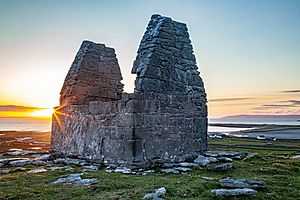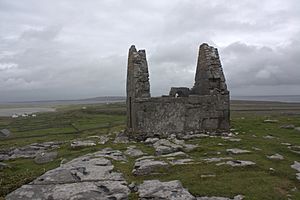Teampall Bheanáin facts for kids
Teampall Bheanáin is a very old building in Ireland. Its name means "Benan's Temple." It's a special type of small church called an oratory. You can find it near Kilronan on Inishmore, which is one of the Aran Islands in Galway Bay, Ireland. This ancient building shows a unique way that churches were built by the Celts long ago.
It stands where a very old religious community was started by Benen. Benen was a student of St. Patrick, who is Ireland's most famous saint. Teampall Bheanáin was built around the 11th century, which means it has been standing for about a thousand years!
Contents
Teampall Bheanáin: An Ancient Irish Church
What is Teampall Bheanáin?
Teampall Bheanáin is not a regular church where many people would gather. It's thought to be a special tomb or shrine for Saint Benen. This is probably why it survived for so long. Other buildings nearby, like a round tower and a medieval monastery, were taken apart. Their stones were used to build a strong coastal fort during the time of Cromwell. That fort is now in ruins.
Where is Teampall Bheanáin Located?
This oratory sits high up on a ridge. From this spot, it looks out over the sea, especially the southeast side, which is where ships would approach the main island port. It has no roof, and its tall, square walls look very striking against the sky. Some people think it looks a bit like buildings from the East.
What Makes Teampall Bheanáin Special?
Even though it looks big from the outside, the inside of Teampall Bheanáin is quite small. It measures only about 3.2 meters long and 2.1 meters wide. It was built using huge stone blocks. One single stone slab makes up half of one side of the building! The stones were put together very carefully with mortar.
The thick walls have a narrow doorway on the north side. This doorway has three stone beams above it and slanting sides. There's also a small window on the east side. This window has a single, curved stone at the top, like an eye watching over the mainland of Ireland. The altar inside faces south, which is unusual. Usually, altars face east or west, and no one knows why this one faces south.



